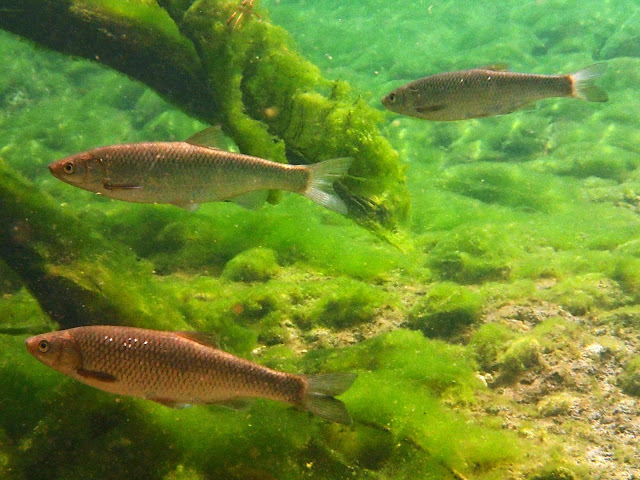
More snorkeling photos to show the beauty - the amazing feeling - of snorkeling in mountain waters. Our HCMR surveys in these waters are going to be scientific - very meticulous - measuring many details not just fishwatching; however, anyone can snorkel. If you can take nature notes of what they see, and/or take photos you can participate in a natural history learning project. During our recent initial survey in the Pindos Mountains we just applied this kind of protocol - what is simply called a "look-see" approach.
If you do take notes you can actually implement a Rapid Fishwatching Survey (RFS) which is nothing more than a simple look-see technique yourself. Here I introduce the method in brief.
This is all you need:
-Underwater notepad
-Watch to keep track of time
-U/w Camera is optional but may really help identification/documentation
What you do:
First decide where you will snorkel and why. Each site snorkeled is one "sample" that is recorded in a database. At each site try to snorkel a fair length, taking in all representative habitat types. Usually a river length of at least 20 times the river width is appropriate. A key objective is to observe and record the "structure of the fish community"; and different fishes and different fish size-categories will be in different habitats. Try to spend at least 30 minutes looking for fish. Spend time floating motionless. Always record precisely the time entering and leaving the water - in this way you will know that at some sites you may have under-recorded or poorly "sampled" due to less time (so time is a measure of a "unit of effort"). Record habitat conditions (i.e. give the habitat types you surveyed in percentage categories pool: 40%, Run 20%, Riffle 10%, Glide: 29%, Rapid 1%). Also give a similar percent estimation of substrate type (rock, boulder, cobble,pebble, gravel, sand etc). Refer to woody debris or other special habitat conditions (marshes, backwaters, deeper reaches, springs) and provide references to species behaviour. Record other species observed (frogs, snakes). Photograph or film the reach you sampled above and below water.
The most important thing is the "species list" for each RFS sample. The idea is to record the numbers of each species (and usually the numbers per size-class category). This may be done in various ways depending on your personal interest and level of rigor. The simplest list is a check-list with rough numbers and notes. The most important thing is to find a way of doing this and keeping it consistent. Most people keep size-class data (i.e. they divide fish seen not only in species units but species size-class categories). Size is a very important attribute of the community of fishes.
For example,
A hypothetical sample list can be like this:
Epirus riffle dace: 20 (<5 cm), 5 (6-10 cm), 1(11-15 cm)
Peloponnesian Chub: 100s (<5), 20s (6-10 cm), 50s (11-15 cm), 1(c. 40 cm).
Peloponnesian Barble: 1000s (<5). Note: no adult fish seen!!!
Note that the 100s, 10s means hundreds, tens; and this is a very very rough 'guesstimated' statement - this is a low-rigour way of giving relative semi-quantitative appraisals. But its MUCH BETTER than saying "many, lots, abundant". Also the "c." shows that the length for the particular individual fish is estimated roughly.
So buy a wetsuit and think of snorkelling with a purpose....
-------------
This post photographically supplements my report during our inception survey in the EcoFlow project. All snapshots below are taken in the upper Acheloos and Aracthos river basins in the Pindos Mountains of Northwestern Greece during five days in mid september 2013. For more about this trip see my first posting below.
(...press photos below, to enlarge!)




















